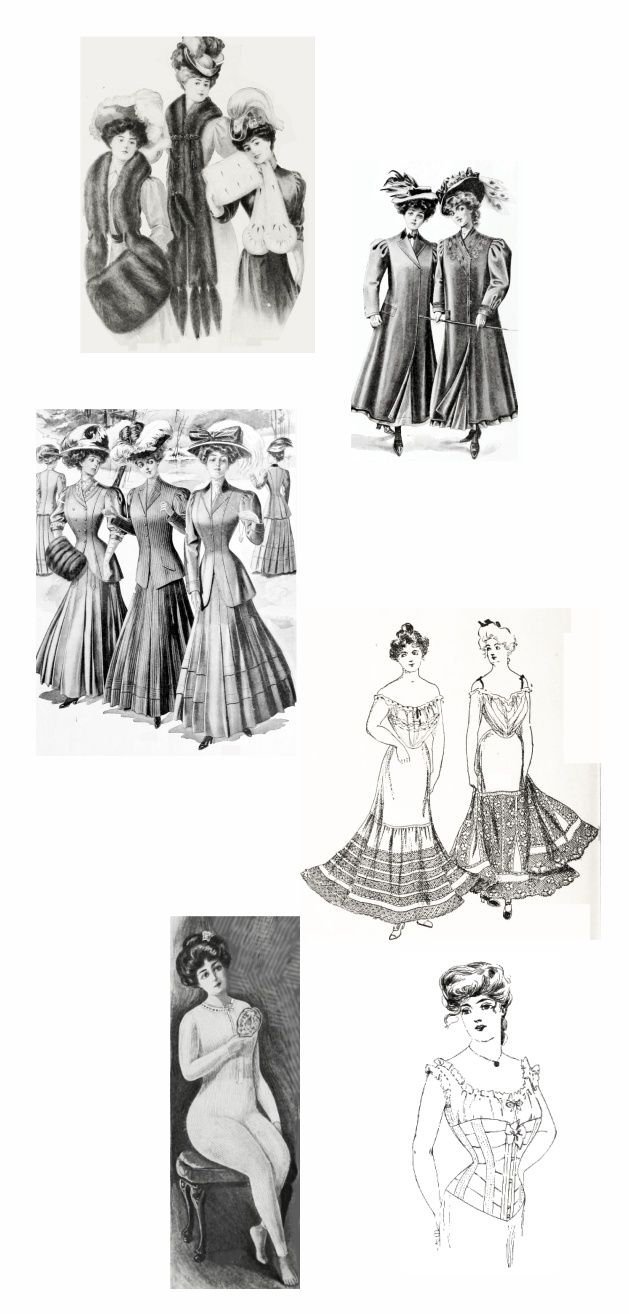|

|

|
Below zero temperatures
December of 1903 was the ninth coldest December in Chicago's history.
When people dressed for that day's
outing to the city, it was four degrees below zero.
They had to travel by train and/or carriage to get
to downtown Chicago. Once there, many then had to
walk one to two blocks from the train station to the
theater. Since they were going downtown and to the
theater, fashion would have been a consideration,
but warmth probably took precedence.
Weight
In 1903 there were fur muffs and scarves atop outer
coats and/or suits, atop dresses, atop petticoats,
atop corsets and stockings, and for some, atop union
suits. One report estimates the average lady wore an
amazing thirty-seven pounds of clothing.
There is no way to know how many Iroquois matinee
attendees checked their outerwear but, based on
witness testimony and the
pile of garments collected after the fire, it is safe to say that
for many, escape was made more difficult by a
reduction in agility caused by ankle-length
garments, extra weight and
bulkiness. In their struggle to survive,
audience members left behind hats, coats,
muffs, even shoes.
Fashioned to death.
Protected from flames by bodies; crushed to
death by bodies.
Fashion killed women at the Iroquois. Corsets
constrained breathing in a situation in which
even small amounts of oxygen were a matter of
life and death. Long skirts were stepped
on, pulling women to their knees and then to the
floor where they were trampled, their bodies
becoming obstacles on which others tripped and
fell, creating piles of victims, all pleading
for help and desperately grasping anything they
could reach, which usually meant the skirts of
other women and girls. Some women at the bottom of such
piles were insulated from flames by other bodies but
were suffocated — not from smoke but when their lungs were
crushed from the weight of those same bodies.*
Hand-stitched seams probably saved lives at the Iroquois Theater
Post-fire photos taken inside the auditorium
show scraps of fabric littering railings and
seat backs, and reports from people who observed
survivors fleeing the theater often mentioned
torn clothing. Curiosity led me to a
failed attempt to tear contemporary garments.
Could I do so if my life depended on it?
No way, but could someone stronger do so?
A chance visit at an antiques auction gave me
the opportunity to examine the stitching on a
homemade dress from the early aughts. The
stitches were straight and uniform but longer
and looser than I expected. I could have
easily torn away the sleeves or the bodice from
the skirt. That led me to seek input from
a recognized authority and author on antique
clothing who confirmed that the seam strength of
hand stitched garments was weaker than seams on
machine stitched garments.
Ready-to-wear garments with machine-stitched seams were not
yet universal in 1903 and the days of a sewing
machine in every home was a couple years off.
The evidence of both situations is that the 1900
U.S. Census and 1903 Chicago city directories
were filled with listings for dress makers.
It was still a thriving cottage industry.
As it related to the Iroquois disaster, family
members searching for loved ones in Chicago
morgues oftentimes brought scraps of fabric from
the dress or shirt the victim had been wearing
when they went to the theater. Whether
they retrieved the scrap from a chest at home or
from the family's favorite dressmaker, they were
able to do so because the garments had been
homemade, and evidence of torn clothing at the
Iroquois says many had been hand stitched.
Had the seams not failed, more women would have
been drawn into body piles by the death grips of
those trapped at the bottom.
|
|
Discrepancies and addendum
*
According to a 1917 article by Chuck Remsberg, former editor of Force Science
News,
six-hundred-twenty-five pounds of compression on a
person's chest is fatal.
With the average weight of women in 1903
being around one-hundred-twenty-five pounds,
and an average chest thickness of fifteen
inches, victims at the bottom of the six-
and eight-foot high stacks of bodies found
at the Iroquois were weighed down by four to
seven bodies, amounting to five hundred to
800 pounds.
|
